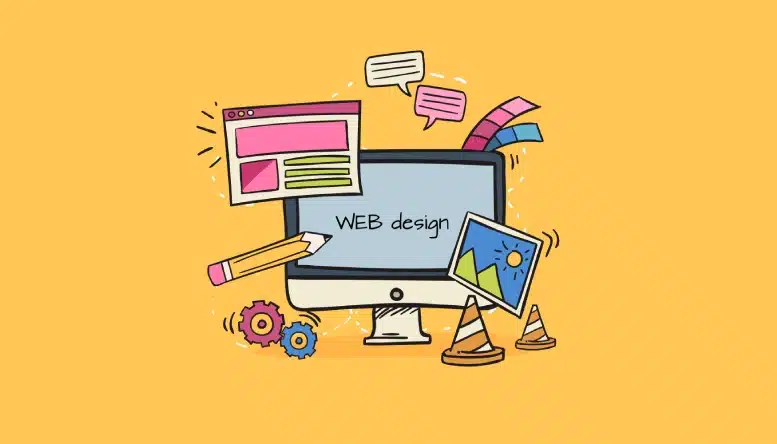7 Proven Web Design South Africa Techniques That Boost User Engagement
Wiki Article
The Crucial Components of Efficient Website Design: A Comprehensive Guide
Reliable internet Design includes various crucial elements that greatly impact user experience. It requires mindful consideration of variables such as mobile responsiveness, intuitive navigation, and aesthetic power structure. Each component plays a crucial duty in crafting a site that not just brings in site visitors yet also keeps them. Understanding these fundamental facets is essential for services aiming to boost their on-line presence. Yet, what truly differentiates a successful web site from its competitors?Recognizing Customer Experience (UX) Design
Customer experience (UX) Design acts as the foundation of effective web Design, concentrating on how users interact with a site. It encompasses various elements, including functionality, accessibility, and overall contentment. An effective UX Design starts with customer research, recognizing the target market's habits and needs. Wireframes and models are then created to envision the web site's structure and flow. Seo Company Klerksdorp. Checking with genuine individuals gives beneficial understandings, allowing developers to fine-tune the interface and boost navigating. Aesthetic Design aspects, such as typography and color pattern, boost the total aesthetic while sustaining capability. Ultimately, efficient UX Design guarantees that customers can conveniently achieve their objectives, promoting engagement and loyalty. By focusing on user experience, internet sites can achieve greater conversion rates and a positive track recordValue of Mobile Responsiveness
As mobile phones significantly control net use, ensuring mobile responsiveness has actually ended up being crucial for effective internet Design. Websites that are not enhanced for mobile can cause an inadequate user experience, resulting in greater bounce prices and shed possibilities. A mobile-responsive Design allows material to adapt effortlessly to numerous screen sizes, making sure that users can access details quickly, no matter the tool they make use of. Furthermore, internet search engine prioritize mobile-friendly sites in their rankings, making responsiveness a crucial variable for visibility and traffic. With an expanding variety of customers accessing the web using tablet computers and smartphones, businesses should buy mobile responsiveness to improve user engagement, improve brand understanding, and inevitably drive conversions. Efficient website design must focus on mobile responsiveness to stay affordable in today's electronic landscape.Crafting Instinctive Navigating
Navigation works as the backbone of any effective site, assisting site visitors with web content effortlessly. An user-friendly navigation structure enhances customer experience by enabling individuals to find information rapidly and efficiently. Clear labeling of menu products is vital; it must show the material properly, staying clear of lingo that may perplex customers. Furthermore, a rational pecking order is essential, enabling customers to recognize partnerships in between different sections. Consistency throughout pages helps reinforce expectations, while breadcrumbs give context and a sense of direction. Receptive navigating food selections that adjust to different tools better improve availability. Eventually, the goal is to develop a smooth trip for visitors, guaranteeing they can check out the site without aggravation, resulting in a more involved and pleased audience.Utilizing Visual Pecking Order
Aesthetic power structure plays an essential function in website design by assisting users' attention and improving their experience. Efficient format techniques, in addition to thoughtful options in shade and typography, can substantially affect exactly how info is perceived and refined. Recognizing these components is important for developing aesthetically enticing and useful web sites.Value of Visual Pecking Order
Efficient website design rests on the principle of visual hierarchy, which overviews customers with web content in a user-friendly and sensible fashion. This principle is important for boosting customer experience, as it helps prioritize info and directs focus to important components. By establishing a clear hierarchy, internet designers can assure that customers conveniently identify essential messages, phones call to activity, and navigation options. A well-structured aesthetic hierarchy decreases cognitive load, allowing customers to refine details successfully. In addition, it fosters involvement by producing an appealing format that welcomes exploration. Ultimately, recognizing the value of visual pecking order is necessary for any kind of internet designer intending to produce effective and easy to use websites that successfully connect their intended messages.
Techniques for Efficient Design
A well-organized layout acts as the foundation of any successful website design, permitting individuals to easily browse with content. Effective methods include grid systems, which offer a structured framework for straightening components, guaranteeing consistency and balance. Furthermore, using whitespace strategically can boost emphasis on crucial locations, minimizing aesthetic mess and leading individual focus. Focusing on content via dimension and positioning further highlights essential details, while different aspects can create a clear aesthetic hierarchy. Implementing receptive Design methods assurances layouts adjust perfectly across tools, maintaining use. Finally, integrating intuitive navigating help, such as buttons and menus, boosts user experience, making it easier for site visitors to locate relevant information promptly. With each other, these methods create the foundation of an effective web design.Shade and Typography Choices
While shade and typography options might appear like simple Design aspects, they play a necessary duty in establishing visual pecking order on a site (Web Design Johannesburg). Shade can guide individuals' interest, differentiate sections, and convey brand identification. By tactically utilizing contrasting colors, developers can highlight vital calls to action, guaranteeing they stand apart. Typography, on the other hand, affects readability and individual involvement. An appropriate font can communicate tone and character, while varying font sizes and weights can create a clear structure. Bigger, bolder headings attract interest, Internet Advertising In South Africa while smaller body text provides thorough details. With each other, efficient color and typography options develop a cohesive visual experience, leading customers with the material effortlessly and boosting general functionalitySelecting the Right Color Design
How does one select the perfect color design for a site? Selecting the best color design is essential for boosting user experience and communicating the brand name's message. Designers need to start by considering the target market and the feelings that different colors evoke. Blue usually indicates trust, while red can produce seriousness. It is necessary to restrict the scheme to a couple of complementary colors to keep visual consistency and prevent overwhelming users. Making use of devices like color wheel applications can help in selecting shades that work well with each other. Additionally, developers should guarantee that there suffices comparison between message and background shades for readability. Ultimately, a well-thought-out color design can substantially impact a web site's efficiency and user involvement.Incorporating Engaging Web Content

Engaging material is important for maintaining the attention and recording of web site visitors. It functions as a bridge in between the website's Design and the customer's experience, promoting deeper connections. Efficient material commonly includes a mix of helpful posts, charming visuals, and interactive components that motivate customer involvement. By using narration techniques, websites can evoke feelings, making the material more relatable and unforgettable. Additionally, incorporating user-generated content, such as testimonials or testimonials, improves reputation and constructs count on with the audience. Clear calls-to-action overview individuals towards preferred outcomes, guaranteeing they continue to be engaged. Generally, a tactical approach to material advancement not just improves user experience yet also drives conversions, making it a vital element of effective website design.
Maximizing for Speed and Efficiency
Optimizing for rate and efficiency is vital for boosting user experience on a website. Methods such as photo compression, minifying CSS and JavaScript, and leveraging internet browser caching can considerably decrease loading times - Seo Company Klerksdorp. These strategies not only improve efficiency yet also add to much better online search engine rankingsPicture Compression Techniques

Minifying CSS and JavaScript
Although numerous internet developers focus on picture optimization, minifying CSS and JavaScript is just as crucial for boosting internet site speed and performance. Minification involves getting rid of unnecessary characters from code, such as whitespace, comments, and format, without affecting its performance. This procedure leads to smaller file dimensions, which causes quicker filling times and enhanced customer experience. By lowering the amount of data moved between the client and the web server, minification assists decrease transmission capacity use and enhances general website efficiency. In addition, online search engine prefer quicker web sites, which can boost search positions. Applying tools and automated processes for minifying these scripts can simplify web advancement and upkeep, guaranteeing that efficiency remains a concern throughout the lifecycle of a website.Leveraging Web Browser Caching
Leveraging browser caching substantially enhances web site rate and efficiency by saving often accessed sources in your area on a user's device. This technique reduces the demand for duplicated demands to the web server, considerably lowering filling times for returning site visitors. By utilizing HTTP headers, web designers can specify caching policies for different resources, such as scripts, stylesheets, and photos. Appropriately carried out caching approaches allow users to experience faster web page loads, causing improved customer fulfillment and engagement. In addition, internet search engine favor websites with optimized efficiency, potentially enhancing search positions. Consistently reviewing and managing cache setups assures that users receive up-to-date material while still gaining from the performance of cached resources. To conclude, effective internet browser caching is an essential component of maximizing web performance.Frequently Asked Inquiries
Exactly how Do I Select the Right Website Design Tools?

Picking the ideal web Design devices involves reviewing task needs, recognizing customer needs, and reviewing numerous software attributes. Compatibility, ease of usage, and area support are additionally necessary elements to think about for reliable Design outcomes.
What Are Typical Web Design Blunders to Prevent?
Common website design errors to avoid include cluttered designs, poor navigating, insufficient mobile responsiveness, slow packing times, and overlooking user experience. Efficient styles prioritize accessibility, capability, and simpleness to involve users and boost complete satisfaction.How Can I Gauge My Site's Success?
To measure a web site's success, one might evaluate metrics such as traffic, conversion rates, user interaction, and bounce rates. Utilizing tools like Google Analytics can provide beneficial understandings for ongoing optimization and enhancement techniques.What Role Does Search Engine Optimization Play in Internet Design?
SEO significantly affects web Design by guaranteeing that internet sites are structured for internet search engine presence. This includes maximizing site speed, mobile responsiveness, and material quality, ultimately improving customer experience and driving organic traffic.How Usually Should I Update My Internet Site Design?
The regularity of website Design updates depends on sector fads, user comments, and technological advancements. Normally, a refresh every 2-3 years is recommended, ensuring the website stays relevant and lined up with existing standards and customer expectations.Individual experience (UX) Design offers as the foundation of reliable web Design, focusing on exactly how individuals communicate with a site. With a growing number of individuals accessing the net via tablets and smartphones, businesses need to spend in mobile responsiveness to improve individual involvement, enhance brand assumption, and inevitably drive conversions. An user-friendly navigating framework boosts customer experience by allowing customers to discover details swiftly and effectively. Properly executed caching techniques allow customers to experience faster web page loads, resulting in enhanced individual satisfaction and interaction. The frequency of web site Design updates depends on industry trends, individual feedback, and technological innovations.
Report this wiki page